

First Amendment to the United States Constitution. The First Amendment (Amendment I) to the United States Constitution prohibits the making of any law respecting an establishment of religion, impeding the free exercise of religion, abridging the freedom of speech, infringing on the freedom of the press, interfering with the right to peaceably assemble or prohibiting the petitioning for a governmental redress of grievances.
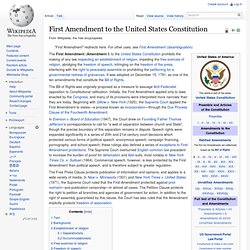
It was adopted on December 15, 1791, as one of the ten amendments that constitute the Bill of Rights. The Bill of Rights was originally proposed as a measure to assuage Anti-Federalist opposition to Constitutional ratification. Initially, the First Amendment applied only to laws enacted by the Congress, and many of its provisions were interpreted more narrowly than they are today. Beginning with Gitlow v. New York (1925), the Supreme Court applied the First Amendment to states—a process known as incorporation—through the Due Process Clause of the Fourteenth Amendment. In Everson v. Text Background In Reynolds v. U.S. ‘Wall Of Separation’: A Carefully Constructed Edifice Of Misinformation « The Wall of Separation. Religion and the Founding of the American Republic (Library of Congress Exhibition)
This exhibition demonstrates that many of the colonies that in 1776 became the United States of America were settled by men and women of deep religious convictions who in the seventeenth century crossed the Atlantic Ocean to practice their faith freely.
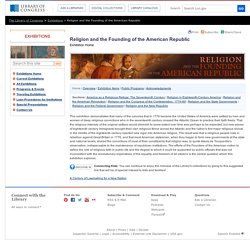
That the religious intensity of the original settlers would diminish to some extent over time was perhaps to be expected, but new waves of eighteenth century immigrants brought their own religious fervor across the Atlantic and the nation's first major religious revival in the middle of the eighteenth century injected new vigor into American religion. The result was that a religious people rose in rebellion against Great Britain in 1776, and that most American statesmen, when they began to form new governments at the state and national levels, shared the convictions of most of their constituents that religion was, to quote Alexis de Tocqueville's observation, indispensable to the maintenance of republican institutions.
James Hutson - Biography. Jefferson's Letter to the Danbury Baptists (June 1998) - Library of Congress Information Bulletin. To messers Nehemiah Dodge, Ephraim Robbins, & Stephen S.
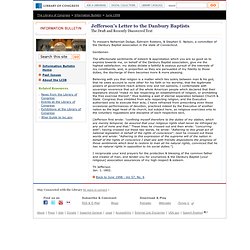
Nelson, a committee of the Danbury Baptist association in the state of Connecticut. Gentlemen The affectionate sentiments of esteem & approbation which you are so good as to express towards me, on behalf of the Danbury Baptist association, give me the highest satisfaction. my duties dictate a faithful & zealous pursuit of the interests of my constituents, and, in proportion as they are persuaded of my fidelity to those duties, the discharge of them becomes more & more pleasing. [Jefferson first wrote: "confining myself therefore to the duties of my station, which are merely temporal, be assured that your religious rights shall never be infringed by any act of mine and that. " I reciprocate your kind prayers for the protection & blessing of the common father and creator of man, and tender you for yourselves & the Danbury Baptist [your religious] association assurances of my high respect & esteem.
Th Jefferson Jan. 1. 1802. Jefferson's Letter to the Danbury Baptists (June 1998) - Library of Congress Information Bulletin. To messers.
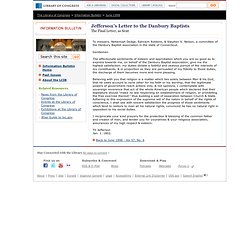
Nehemiah Dodge, Ephraim Robbins, & Stephen S. 'A Wall of Separation' (June 1998) - Library of Congress Information Bulletin. By JAMES HUTSON Following is an article by the curator of a major exhibition at the Library that opens this month and runs through Aug. 22.
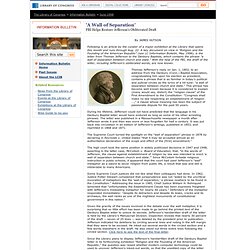
1st amendment documentary. The Mythical "Wall of Separation": How a Misused Metaphor Changed Church–State Law, Policy, and Discourse. First Principles Series Report #6 First Principles Series Report - The First Principles series explores the core ideas of the American founding and the importance of renewing those ideas today.
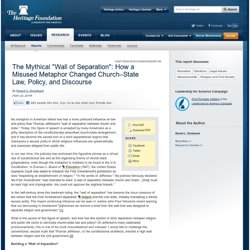
The Mythical "Wall of Separation": How a Misused Metaphor Changed Church–State Law, Policy, and Discourse By Daniel L. Dreisbach June 23, 2006 Share No metaphor in American letters has had a more profound influence on law and policy than Thomas Jefferson's "wall of separation between church and state. " In our own time, the judiciary has embraced this figurative phrase as a virtual rule of constitutional law and as the organizing theme of church-state jurisprudence, even though the metaphor is nowhere to be found in the U.S. Jefferson's Wall of Separation Letter. Thomas Jefferson was a man of deep religious conviction — his conviction was that religion was a very personal matter, one which the government had no business getting involved in.
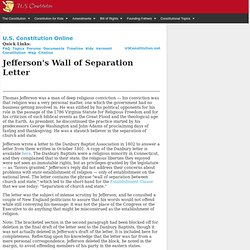
He was vilified by his political opponents for his role in the passage of the 1786 Virginia Statute for Religious Freedom and for his criticism of such biblical events as the Great Flood and the theological age of the Earth. As president, he discontinued the practice started by his predecessors George Washington and John Adams of proclaiming days of fasting and thanksgiving. He was a staunch believer in the separation of church and state. Jefferson wrote a letter to the Danbury Baptist Association in 1802 to answer a letter from them written in October 1801.